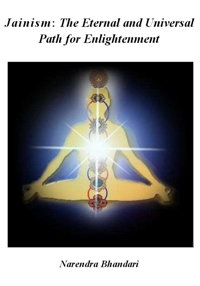One who believes in karma can do no wrong and can never be unhappy.
Types of karma
Elimination of Karma:
Āṣrava (inflow),
Bandh (bondage),
Saṁvara (protection),
Nirjarā (cleansing),
Mokṣa (emancipation)
The physical processes occurring in the universe follow the law of causality "Nothing happens without a cause and every action has an effect". This law of causality, applicable to sentient beings, in the spiritual domain is Karmavād of Jainism. In our day to day experience we may find that deeds and destiny are apparently not related, or they are not in conformity with cause and effect relationship, yet Jainism believes that every physical action has a physical effect on the body and mind and every mental action (thought) affects the mind and sometimes also the body. Both physical and mental actions affect the soul, but the consequences of Bhāv (thought or attitude) on the soul are dominant. Every action or thought (physical or mental) results in bondage of the soul. A person has the freedom to act in any way he likes but has no choice in facing the consequences of that action because he is bound by the law which cannot be violated. What we are now is the cumulative effect of our past karmas (in previous and present life) and what we will be in future will be determined by our karmas accumulated up to this life. Good or bad, both types of actions result in bondage; they cannot be annulled by each other i.e. a good act cannot cancel the bad act of equal magnitude but one has to go through the consequences of each of them separately. That is, Karmas are non-additive. When the bondages due to each, good as well as bad, karmas are completely eliminated, one attains Mokṣa. Influence of some types of karmas can be made milder by certain techniques and their severity can be reduced or postponed whereas there are others, consequences of which have to be experienced in full measure. Liberation from both these types of the binding karmas is the goal of the soul. The inevitability that one has to face the consequences of his actions, sooner or later, will refrain one from wrong-doing, even in trivial measure, and the concept that “the unhappy patches in life are a consequences of the past karmas, which cannot be avoided or erased" will provide him the necessary strength of facing them without suffering. The lack of causal relationship between karma and its immediate consequences in the current life is explained by eternity of soul, rebirth and fructification of karma at some later, appropriate time.
The stage or Guṇsthān at which the soul is located depends only on bondage of one's accumulated karmas. Souls take birth at appropriate stage determined by the karmas of the previous births. Upon death, the soul leaves the physical body, leaving all the physical objects of desire here on earth but carries with it the karmas, past and present.
It immediately follows that no one, not even "God", if He existed, can help one from going through the consequences of his karma or actions.
In this world, one cannot exist without acting in some way or the other all the time. So that the key to mokṣa is to act without acquiring karma. It does not mean that one should not act but how to act so that there is no bondage? One should act without passion, attachment, expectation, but not without purpose of achieving mokṣa. The path or procedure accomplishing this goal is via saṁvara (stopping to acquire new karmas), and nirjarā (shedding old karmas).
Karmas have consequences, at physical, mental, and consciousness level and bind the soul to its actions. Karmas are cumulative. Surprisingly, they do not fructify instantaneously but there is a period of dormancy before they arise. This explains the apparently different fate for different persons which seems unrelated to their deeds and efforts in the present life.
There are infinite types of Karmas but they can be classified in a few groups, mainly eight. Of these four are destructive (Ghāti karmas) and the other four are non-destructive (Aghāti), as mentioned below, but the soul carries all of them with it at birth. Ghāti karmas affect the soul and subdue its purity whereas Aghāti karmas only affect the physical environment and worldly traits of a living being. These form two repositories, sanchit karma and arjit karma. Sanchit karma is accumulated over previous lives or past and Arjit karma is acquired by actions in the current life. Karma can arise when the time is ripe; in the meanwhile it remains dormant, but does not cease to exist. Why the consequence of karmas is not instantaneous? Why they remain dormant for variable periods? It is because the consequences of karmas are not allowed to be faced in an approximate manner. Therefore one has to wait till the physical conditions or situations are suitable and are precise for karmas (nām karma, gotra karma etc.) to satisfy with exactitude before the consequences of other karmas can fructify? A million combinations are required for the karmas to arise so that the consequences could precisely match them. Science of karma is an exact science. Its fructification then is a statistical phenomenon, waiting in search for the right combination. Sometimes the conditions can be met immediately and suitable results may be quick to follow whereas in other case it may take time for exact conditions to be met and the consequences may be much delayed.
The various important group of karmas are as follows:
- Jñānāvaraṇīya (Wisdom deluding) karma:
The most serious is the jnānavarniya karma as it blurs the acquisition of true knowledge, which is the basis of Moksa. Once one is convinced that the life has the purpose of attaining Moksa, search of truth is the only way and all the souls (jiva) are entangled, then one follows the path of Ahimsa (non-violence) in thought, speech and deed and acquires manah paryāy and Kevaljñān. Keval Jñān is omniscience or anantjñān, a state when one knows everything, in past, present and future, not through sensory organs but in a super sensuous way. - Darṣanāvaraṇīya karma (perception deluding) karma:
It blurs the acquisition of correct perception through sensory organs and mind as also the extrasensory perception. Once one perceives the existence of soul and the six cardinal truths (Chapter 2) and has full faith in laws of karma, this delusion ends and one acquires samyak Darsan. Understanding Anekāntavād (chapter 3) is essential for attaining samyak Darsan. - Vednīya karma:
It determines the potential for suffering pain or pleasure. When one has mastered the mind to remain calm and detached to worldly events then this karma is eliminated. - Mohanīya karma:
This karma is acquired due to attachment with the worldly possessions and pleasures through māyā (physical attachment), krodha (anger), mada (pride, ego) and lobha (greed, possessions). It can be called charitravarnīya karma, which inhibits just and proper conduct. When one has mastered total detachment and follows the path of total forgiveness to all living beings than this karma is eliminated. In practice, krodha, māyā, mada and lobha cannot be just stopped because mind cannot exist in vacuum, and therefore they should be replaced by Kshamā (forgiveness), Saralatā (simplicity), vinay (humility) and santosh (contentment) respectively. When this is achieved, the soul is free of passions and mohaniya karma is eliminated.
- Ayush karma:
It determines the life span in the new incarnation. - Nāma karma:
It determines the personal traits of a jiva like body and health. - Gotra karma:
It determines the yoni (species), family, social status etc in which a jiva will be reborn. - Antarāya karma:
It determines the various obstacles one faces in accomplishing his goals.
Each of these karmas are further sub-divided into many groups, but it will suffice here to say that there are procedures for eliminating various karmas as discussed in Chapter 6. Each of these karmas are accrued in three ways, by physical action, by thought and by consent (anumodan) approving it to be done by others. Therefore one must not only refrain from wrong doing by himself, and not even think of wrong doing but also refrain from approving wrong doing by others. Karmas get bound to the soul and make it impure. How do the physical karmaṇus get attached to the non-physical soul? According to some Achāryas (e.g. Abhaydev Suri) the karmic matter (Karmāṇu) is fastened to the soul by leṣyās. Leṣyā is a kind of psychic colouration and is of six types: namely black, blue, grey, fiery, yellow and white. The colour implies gradation from bad (pāp) to good (punya) types of karma, white representing the highest punya karma.
Karma, Jñān and Gunsthāṇs are intimately related. As the bad karmas are shed, one move to higher spiritual stage and acquires higher level of Jñān. We will discuss these aspects in the next chapter.
 Prof. Dr. Narendra Bhandari
Prof. Dr. Narendra Bhandari
